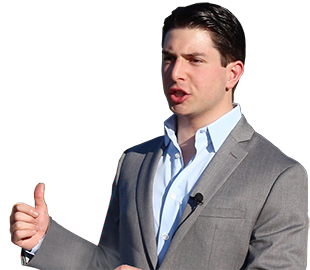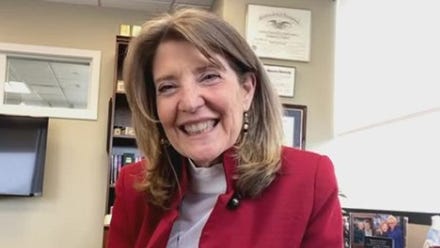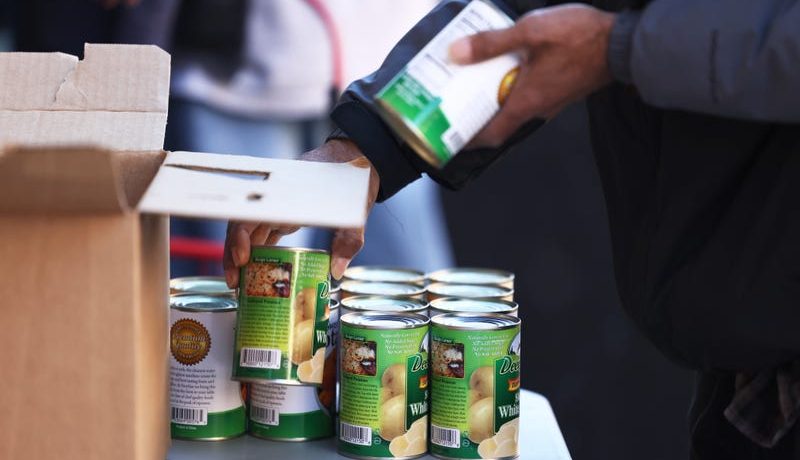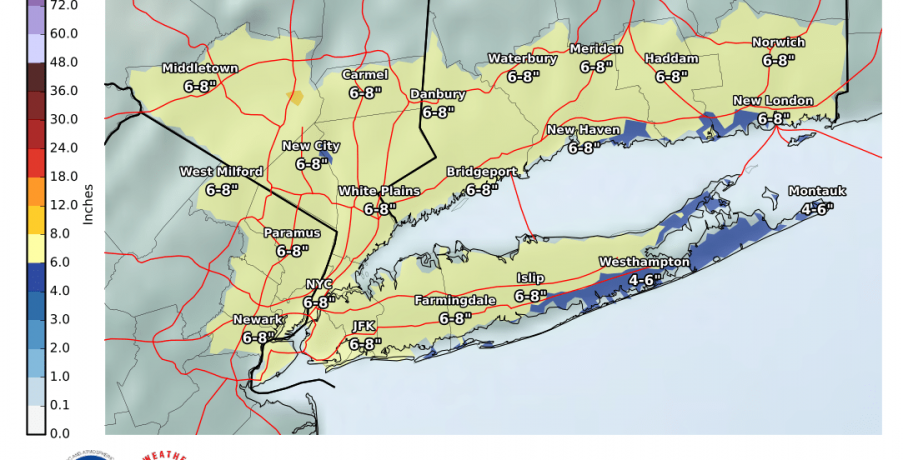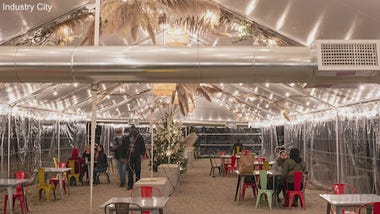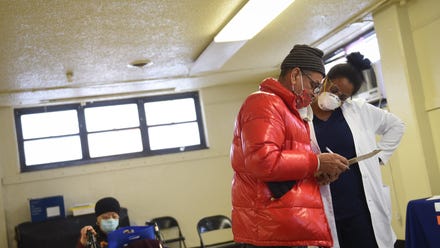
-
Small Business Spotlight: Cindi Bigelow Shares Tips for Surging Online Sales as Retail Remains Sluggish
Post Views: 693By Joe Connolly and Neil A. Carousso
NEW YORK (WCBS 880) — It’s no surprise online sales have surpassed retail sales given pandemic restrictions, but Bigelow Tea’s third-generation president and CEO Cindi Bigelow understands exactly how to grow her fan base.
“It’s very important that you build out each page for each product with as much as you can both from a visual perspective and a verbal perspective so that you have to make that product come alive,” said Bigelow on the WCBS Small Business Spotlight, sponsored by Dime Community Bank.
She calls this the “digital shelf,” likening it to a store shelf that should capture shoppers’ attention ideally at eye level.
“We have a team of individuals that literally work on the different places that we are on the web to examine every single page to make sure that page is maximized,” Bigelow said.
She told Joe Connolly and Neil A. Carousso her world famous Bigelow Tea is very much in demand with online sales of some teas surging beyond 100 percent. But, the overall business is only up 6 percent while retail, restaurants, offices and universities are closed or limited 11 months after COVID-19 shut down large swaths of the U.S. economy.
“That’s a high hurdle to get over,” she said.
Bigelow’s manufacturing plant based in Fairfield, CT. She employs 400 workers at her family business with 300 employees in manufacturing who are required to be on-site with safety precautions in place. She expressed concern on WCBS 880 about small businesses that do not have the resources to invest in digital infrastructure.
“What about Main Street?” Bigelow asked with excitement, continuing, “Don’t you want your child to be able to work at the pizza shop down the street during their summers and being able to work at a shoe store?”
She explained she is sensitive to how local businesses have been stifled by the deadly virus and the lack of government relief, noting it could impact generations to come.
Those that are in operation, Bigelow said, need to pay close attention to consumer behavior and changing trends.
“We will listen to absolutely everybody,” she said, using a customer complaint about the lack of “peachiness” in one of her teas as an example. She noted that’s how they “identify what to do better.”
Bigelow’s motto is “the meanest taste bud wins,” meaning she will listen closely to those who offer criticisms to improve her products, which have been on store shelves for 75 years.
That’s one way she limits the echo chamber of “yes men” around her and a way to anticipate changing consumer preferences she applies to tea, but can apply to any industry.
See Joe Connolly and Neil A. Carousso’s conversation with Cindi Bigelow of Bigelow Tea on the WCBS Small Business Spotlight video above.
-
State of Black New York: Income Inequality and Race
Post Views: 858By Lynda Lopez, Marla Diamond and Mack Rosenberg, WCBS Newsradio 880
NEW YORK (WCBS 880) — We at WCBS 880 and Entercom New York are pleased to partner with the New York Urban League to shine a spotlight on issues of inequity in our community in important areas like health care, education, the digital divide, social justice, the economy, and civic engagement.
Last week, we looked into the racial inequities in health care and education.
As we dig into a comprehensive report released by the New York Urban League titled, “The State of Black New York,” we take a deeper dive into the issues of income inequality and race.
https://omny.fm/shows/880-weekly-rewind/special-report-the-state-of-black-new-york-1As the old saying goes, “If you could make it here, you could make it anywhere,” but according to the Robin Hood & Columbia University’s Poverty Tracker, a majority of Black New Yorkers are barely making it.
The tracker found 59% have lived in poverty for at least one of the past four years and 35% of adult New Yorkers who exit poverty fall back in the following year.
Almost 50% of New Yorkers of color lack sufficient income to meet basic family needs.

Dr. Melony Samuels, of the Beford-Stuyvesant-based food pantry Campaign to Fight Hunger in New York City, sees it every day firsthand.
“We have seen an increase of 1020%. Right now we are distributing food to 14,000 families per week, which is beyond the thoughts of what we could ever think,” Samuels said. “We’re seeing that families are in dire need for food. It has been very, very scary.”
Samuels said in the last survey they conducted, 75% of those that have come for food are there because of unemployment.
The New York Urban League found half of the city’s job growth since 2010 has been in industries with average annual wages under $40,000.
“Sixty-one percent of those we serve do have a job, but they struggle in order to put food on the table, and for obvious reasons. The rents are very high in New York City,” Samuels said.
Before the pandemic, gains were being made in the city’s communities of color, said Noreen Springstead, executive director of WhyHunger.
“The hunger numbers were actually moving down, we were making a lot of progress. As soon as the pandemic hit, they skyrocketed. I think most people have seen those long lines of people in need, really human suffering, looking for food to feed themselves and their families. So it’s not a new problem, however, it has been exacerbated by the pandemic,” Springstead said. “We have skyrocketing hunger. It is the ripple effect and it’s going to take a long time to recover from this hunger crisis.”
Fifty-four million Americans do not have enough food. The undocumented cannot qualify for SNAP benefits to feed themselves or their children.
“The COVID pandemic has really pulled the covers back on what has been true for a very long time — that communities of color suffer at disproportionate rates of health crises, food crises, housing crises, and what it does is creates an opportunity to begin to address those issues much more holistically,” said Sprinstead.
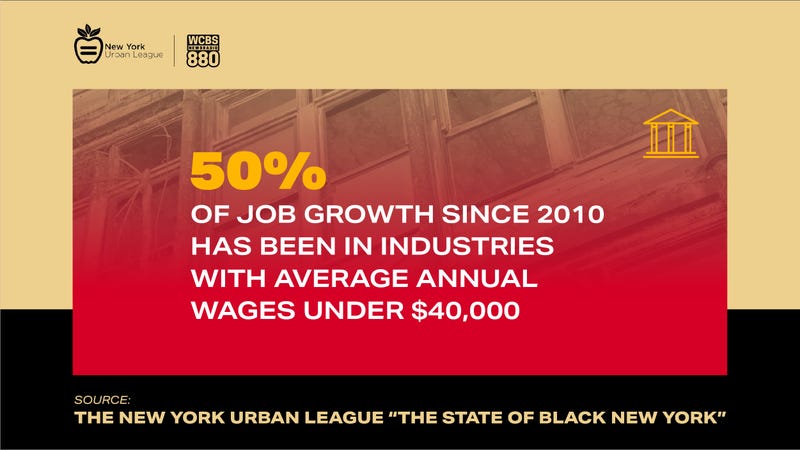
As part of our coverage of this topic, we wanted to engage some of the people running for mayor of New York City to discuss the problems and potential solutions.
Democratic candidate Kathryn Garcia has been in city government for 15 years working in housing, environmental protection and sanitation. Most recently, she worked as the city’s food czar during the early days of the pandemic and saw firsthand the need.
“I think that this is really a tragedy to see these types of numbers, but know that there’s a human face behind them and a human family, usually with kids. And there’s a lot the city can do. Not only does the city need to ensure that we’re supporting people through the safety net programs that we have, but also creating real opportunity for people across the city and particularly for Black people and for women who have shouldered the burden so often in this city and we’re not creating jobs for them,” Garcia said. “That is why I would pair the concept of economic development with workforce development and ensure that those two things go hand in hand.”
Garcia said the city must also guarantee that high-paying jobs are available for students coming out of CUNY.
Garcia is also focused on making the city more affordable.
“First and foremost, when we talk about housing we have to make sure that we are renovating all of the NYCHA apartments and making them high quality places for people to live and raise their families,” Garcia said. “We also need to continue building and build deeply affordable housing for those who are at the lowest incomes levels, but also just make it easier to build housing. We’ve been in a scarcity situation since before I was born.”
Garcia said housing heals.
“We know the virus went rampant in overcrowded housing and got many more people sick because they couldn’t quarantine from each other, we know that it means that you can be much more successful in school, and we know that it’s easier to hold down a job when you have a permanent home,” Garcia said.
Meanwhile, just this week, Mayor Bill de Blasio announced plans to help close the wealth gap in New York City with a program to encourage people to shop at and celebrate Black-owned businesses.
There is no question that COVID-19 has wreaked havoc on local businesses, but studies show that Black businesses are twice as likely to shut down during the pandemic.
There are twice as many white entrepreneurs as Black ones in the city, according to the New York Urban League, and the Black-owned businesses that do exist make up just 2% of the total, and even less than 2% of the employees are Black.
The biggest challenge for Blacks in getting their foot in the door is money. Stats show banks won’t give it to Black as much as they will to whites.
Dawn Kelly, owner of a popular juice bar in Jamaica, Queens, was well aware of those realities when she lost her job in public relations at Prudential a few years ago.
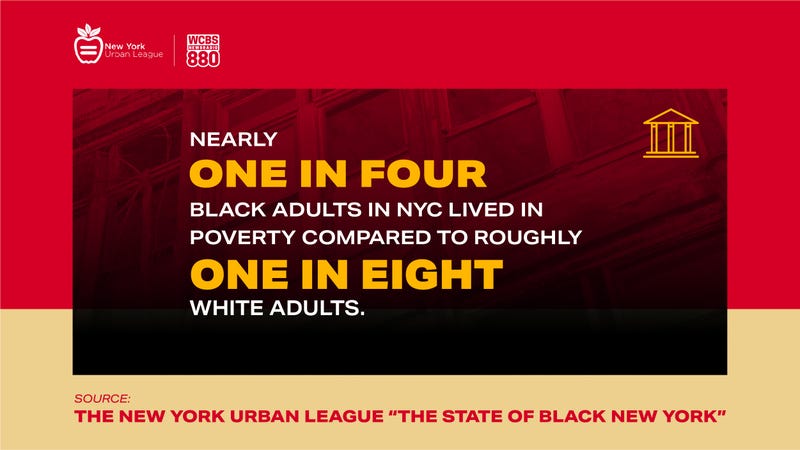
Our Mack Rosenberg asked her whether she thinks she would’ve been able to start her business if she didn’t get a severance package and had to rely on a loan.
“I would tell you that I think it would’ve been challenging and difficult at best,” she said. “The stories are out there. Black people, for the most part, and first time business owners, so I don’t want to just say Black people, but Black people more often than not don’t get the capital from the banks and lending institutions that they need in order to start a business and to sustain a business.”
Aside from her success since opening The Nourish Spot is her success as a mentor to young Black people looking to become entrepreneurs.
Also in on the mission to expand the Black economy is the city’s Small Business Commissioner Jonnel Doris. He started BE NYC, with “BE” standing for Black Entrepreneurs. With funding from the city and big companies like Ernst & Young and Mastercard.
They operate on what Doris likes to call the three M’s — money, mentorship and marketing.
“Help you with access to capital by bringing in new partners like Goldman Sachs and others, making sure that they’re connected to other peers that can help them sort of get through the program, and how do we expand and grow to digital storefronts but also enhance your online presence being that we’re in the pandemic most of what we’re doing online,” Doris said.
He calls Kelly a star, in large part because of her mentoring.
Three young Black people have already started their own businesses thanks to her.
“Because I know more, I must do more. There’s a famous saying in the Black community, ‘To whom much is given, much is required.’ And so I see my life, not really differently than others, I just have made different choices than others, and so because I have had the opportunity to do more, see more, experience more, I see it as my role to teach others,” Kelly said.
Doris said it’s critical for entrepreneurs to help other entrepreneurs like Kelly is doing. But he still sees the financial challenges as a stumbling block.
“These things are critical. What others don’t have to think about when they start a business, the businesses that we’re talking about here today do,” Doris said.
As we round out this week’s reporting on the New York Urban League report on the “State of Black New York,” we wanted to bring in another candidate for mayor.
Ray McGuire has spent his career on Wall Street helping run big companies, including Morgan Stanley and Citi Group.
His is African American and self-made.
Our Lynda Lopez spoke to him this week about his thoughts about the racial divide in the economy.
He said his plan is to lead the largest most inclusive economic comeback in the history of this city.
“Which is to put people to work, give people jobs, move them from no class to middle class,” McGuire said. “My plan is go big, go small, go forward, putting 500,000 New Yorkers to work so that they can earn a wage, earn a living, that takes them from the lower income to the middle income so they can participate in the way that all of us want to participate in this city.”
At the center of his plan, is a focus on infrastructure that includes affordable housing.
“It should not be the case that people make $15,000 to $30,000 a year, who are really essential to how this city works, pay 50% to 60% of their income to rent. That’s not truly affordable, so we need to make certain that we build truly affordable houses,” McGuire said, adding that the digital divide is also an issue he plans to address. “It’s had such a negative impact and profound impact on how we educate our kids and what my plan is, my go big plan, is to focus on building broadband so that people have access. We have 1.5 million New Yorkers, people who are lower income, don’t have access to broadband or mobile and we need to fix that.”
His plan also focuses on small business that he describes as the lifeblood of the communities.
“I have a plan to support the small business with wage concessions, 50% wages, so they can keep their sales tax receipts, so that we cut the bureaucracy and give them relief on many of the fines that have been levied,” McGuire said.
His goal is to uplift the city economically and grow out of this crisis.
https://omny.fm/shows/880-weekly-rewind/cuomos-nursing-home-problem-vaccines-and-texas-powNeil A. Carousso produces The 880 Weekly Rewind with Lynda Lopez Friday nights at 7 PM on WCBS Newsradio 880, including all video content. Listen to this week’s full show on the media player above.
-
Warnings, Advisories in Effect as Another Winter Storm Takes Aim at Tri-State Area
Post Views: 602By WCBS Newsradio 880
NEW YORK (WCBS 880) — Keep those shovels handy!
Another round of winter weather is expected to bring even more snow and mixed precipitation to the Tri-State area.
A winter storm warning has been issued for parts of New Jersey while a winter weather advisory has been issued for New York City, Long Island and other parts of the Tri-State area.
Snow, rain, sleet and ice are making for treacherous road conditions. Our Chief Meteorologist Craig Allen is tracking the storm and let's us know what's in store for tonight. https://t.co/8ifExpdqO0 pic.twitter.com/0PSzu4imsX
— WCBS 880 (@wcbs880) February 18, 2021Snow arrived Thursday morning and continued throughout the day, falling heavily at times. It’s expected to change over to sleet, freezing rain or plain old rain along the coast and in the city Thursday night.
“It will accumulate rapidly because it’s very cold out there,” WCBS 880’s Chief Meteorologist Craig Allen said. “The ground will be frozen.”
Keep those shovels handy! @CraigAllenWx says we're in store for even more snow across New York City and the surrounding areas. He's got the latest on the timing and potential snow totals: https://t.co/b1DvbLOudi pic.twitter.com/2c1ni077Qz
— WCBS 880 (@wcbs880) February 17, 2021During the afternoon hours, some of the major roadways, especially if treated, may see slushy or just wet conditions, but most other areas will have slippery or hazardous travel.
Some lingering snow will continue Friday morning before it tapers down to flurries and moves out.
By the time the storm is all said and done, most of the region will see between 4 and 8 inches of snow, with possibly up to a foot well north and west of city.
“I am sure there’s going to be a few areas that come in with 10, 11, 12 inches of snow, especially interior spots where there is absolutely no changeover,” Allen said. “It’s another prolonged event. It starts Thursday morning, it goes right on through into Thursday night and the first part of the Friday commute.”
Strong winds and coastal flooding are not anticipated with the storm.
Utilities, including Con Edison and PSEG, warn the storm may cause tree limbs to break and pull down wires, causing outages.
Utilities have extra crews on the ready to deal with any weather-related issues caused by the snowstorm.
Ahead of the storm, Nassau County rescheduled COVID-19 vaccination appointments.
“We’re going to reschedule at our Nassau County points of distribution, that’s Yes We Can Community Center, the community college and LIU, we’re going to be rescheduling the Thursday and Friday second dose appointments for Monday,” Nassau County Executive Lauran Curran said.
Curran said the county will work with people who can’t reschedule for Monday.
Sites are expected to be up and running Saturday and Sunday.
Nassau Inter-County Express/NICE Bus advises riders to plan for likely delays and detours on Thursday and Friday.
The MTA said articulated buses will be removed from the road starting Wednesday night ahead of the storm and remaining local buses will be fitted with chains. A 35-mph speed restriction on all MTA Bridges will be implemented once the storm begins.
“The service that’s most likely to be affected is buses,” MTA Chairman Pat Foye told WCBS 880. “We don’t expect there will be a significant impact on subway or commuter rail service.”
MTA employees are in force spreading salt and clearing surfaces of snow and ice, keeping signals, switches, and third rails operating. Crews will also remove any downed trees that may fall across tracks and attend to any weather-related challenges during the storm.
The agency is urging customers to stay home and avoid unnecessary travel during the storm.
“While we are encouraging riders to avoid non-essential travel, the system will be running for the essential workers who need it and we do not expect to have to curtail above-ground service given the current forecast,” said Demetrius Crichlow, Acting Executive Vice President of the New York City Transit Department of Subways. “Crews from New York City Transit will be out before, during and after the storm to make sure staircases and platforms are clear, but customers are still encouraged to check for service changes before they travel.”
In New York City, Open Streets and Roadway Dining are suspended Thursday. Sidewalk dining remains open.
Alternate Side Parking Regulations are suspended through Saturday.
Mayor Bill de Blasio said vaccine sites, testing sites and food distribution sites will remain open during the storm. Some testing sites were however closing early.
The New York City Emergency Management Department has also issued a hazardous travel advisory for Thursday and Friday.
“Thursday’s snow may come in fast throughout the afternoon. We are ready to fight it, as we have throughout this busy winter, but we need all New Yorkers to help by staying off the roads and giving us the space and time to do our work,” said Edward Grayson, Commissioner of the New York City Department of Sanitation.
New Jersey State Police responded to 92 crashes and assisted 55 drivers during the early hours of the winter storm.
Gov. Phil Murphy is urging New Jerseyans to stay off the roads.
He also said the snow here and winter storms across the country are further hampering the vaccine distribution.
“This may result in many appointments needing to be rescheduled,” he cautioned.
Due to the storm, vaccine mega sites are closed in New Jersey, except for the hub located at Rowan University in South Jersey.
Warming centers have been opened statewide in New Jersey.
Suffolk County Police responded to dozens of crashes during the storm, many on Sunrise Highway.
County Executive Steve Bellone is warning the storm will last through Friday afternoon on Long Island.
“Right from the outset of this obviously we’re seeing difficult conditions on the roadway, slick conditions, our big concern of course will be the evening commute,” Bellone said.
Westchester County Executive George Latimer has similar concerns.
“It’s gonna take time to try to keep roads clear and we are concerned about the rush hour today. From the county standpoint we’re having our county workforce leave earlier to try to give them a little bit of advanced notice and we encourage people to stay off the roads if they’re not on the roads,” Latimer said. “By the same token if they do have to leave, try to leave befor the heart of rush hour.”
He said the mass vaccination clinic at the Westchester County Center is open until 7 p.m. Thursday.
Hundreds of flights have been canceled at John F. Kennedy, Newark and LaGuardia airports. Travelers are urged to check with their airlines on their flight status.
Saturday will be partly sunny and brisk with highs in the mid-30s.
Sunday is mostly sunny and cold. The high will be 34.
Neil A. Carousso produces and edits WCBS Chief Meteorologist Craig Allen’s forecast videos.
-
Small Business Spotlight: Industry City Draws Scores of Weekend Shoppers, Positions Retail ‘Partners’ to Succeed
Post Views: 568By Joe Connolly and Neil A. Carousso
NEW YORK (WCBS 880) — Industry City has developed the holy grail of retailing by attracting 10,000 visitors each weekend – 75 percent of pre-pandemic volume – while investing in its tenants’ recovery.
The historic complex bills itself as “Brooklyn’s vibrant creative hub along the scenic waterfront of Sunset Park,” housing 550 local shops, restaurants and manufacturers – many of which have suffered steep losses. But, Industry City’s largely open-air space has allowed them to operate safely. About 40 percent of its tenants have reopened since the shutdown.
“They can safely come, hang out, have a drink, see some music, shop at Sahadi’s, shop at Japan Village, etc. and that’s really helped them considering the environment,” Industry City Director of Development Jim Somoza said on the WCBS Small Business Spotlight, sponsored by Dime Community Bank.
The complex owns its own streets and has sprawling outdoor dining space with large tents for inclement weather.
Somoza was part of the development team of Chelsea Market, starting in 2003, before embarking on Industry City’s vision of new-age retail-tainment featuring innovative local businesses that appeal to Brooklynites and tourists alike.
He told Joe Connolly and Neil A. Carousso about several Industry City tenants, including a blacksmith that entices customers to the waterfront space.
“While they’re coming to see that, they’re also buying a drink at the Frying Pan, they are going to Standard Wormwood and Brooklyn Kura,” Somoza said, adding, “They bring people to the overall project.”
Industry City’s business plan revolves around the experience, which he describes as the “antidote to the Internet.” People are itching for an outlet and Somoza anticipates high post-pandemic demand.
“When we are doing our jobs well at I.C., we’re transporting people,” he said. “We’re taking you away.”
Shoppers can take blacksmith classes at Nazz Forge, savor chocolate as they watch it being made at Li-Lac Chocolates, and watch the Christophe Pourny Studio restore antique furniture on the other side of the glass. This connects consumers and producers on another level through an Epcot-like or Hershey Park adventure in Sunset Park, Brooklyn.
It could be the model for business communities who will need to convince hardened online shoppers to shop local and in-person.
Businesses in Industry City have been set up to recover and succeed. Somoza told WCBS 880 he likes to think of their role as a “partner” to its tenants rather than a “landlord” – a word he avoids using.
“What we do is we support them,” he explained.
At the outset of the coronavirus pandemic, Industry City offered rent breaks, changed leases to percentage rent, and helped business owners navigate the Paycheck Protection Program (PPP) loan applications and requirements.
“I think that’s a part of the reason, with one exception, every single one of our retailers has reopened,” said Somoza.
Small and mid-size businesses there feel they are nearing the finish line at the end of an arduous year, according to Somoza, who noted many are applying for the latest round of the PPP loan.
See keys for creating economic development to recover from the pandemic on the WCBS Small Business Spotlight video above.
-
State of Black New York: The Racial Divide in Health Care and Education
Post Views: 641By Lynda Lopez, Marla Diamond and Steve Burns, WCBS Newsradio 880
NEW YORK (WCBS 880) — Over the next three weeks, WCBS Newsradio 880 is going to be spending time digging into a comprehensive report released by the New York Urban League titled, “The State of Black New York.”
We at WCBS 880 and Entercom New York are pleased to partner with the New York Urban League to shine the spotlight on issues of inequity in our community in important areas like health care, education, the digital divide, social justice, the economy, and civic engagement.
https://omny.fm/shows/880-weekly-rewind/special-report-the-state-of-black-new-yorkArva Rice, President and CEO of the New York Urban League, said the organization utilized data from Robin Hood & Columbia University’s Poverty and Early Childhood Poverty Trackers and also worked with United Way and the New York Women’s Foundation to provide statistical information on how African Americans are faring in comparison to their White counterparts.
“It’s really important for us to release the ‘State of Black New York’ report this year,” Rice said. “Our national office releases the ‘State of Black America’ on an annual basis and we had not released the ‘State of Black New York’ in over 10 years. In conjunction with our centennial, we wanted to be able to have a clearer baseline of how African Americans were doing in several key areas.”
The report not only lays out issue and statistics, it also includes actionable steps to facilitate change.
“It is important for us to shine the light on inequality, but to also provide some concrete strategies and policy suggestions on how to close those disparities and close those gaps,” Rice said.
As we tackle the report, this week reporters Marla Diamond and Steve Burns focus on health and education.
THE RACIAL DIVIDE IN HEALTH CARE
According to the New York Urban League report, one in four Black adults in New York City faced a health problem in 2018.
Today, they are twice as likely to die from COVID-19 than White people — making up 28% of deaths from the virus despite being only 22% of the city’s population.
Elisabeth Benjamin, Vice President of Health Initiatives at the Community Service Society, said this is the result of the state’s 30-year pro-market agenda.
“This is what structural racism looks like in the health care field. So in the 90s, we eliminated any semblance of regional health planning and centralized it up in Albany with a committee controlled by private and voluntary hospitals,” Benjamin said. “Although charities in name often do not act in very charitable ways toward their patients.”
Reimbursement rates were deregulated, allowing the most powerful hospital systems to get stronger, pushing out smaller community hospitals serving poor Black neighborhoods. The health care burden was pushed onto the city’s hospital system, which strained under the weight of the pandemic.
“So that’s why you see the New York Times and many, many articles about what was going on in Elmhurst, which was sort of the last hospital standing in Queens, versus what was going on in sort of well-heeled Manhattan hospitals,” Benjamin said.
The COVID crisis has revealed layers of inequities that The Rev. Calvin Butts sees firsthand at the Abyssinian Baptist Church in Harlem.
“The virus becomes a problem because cancer is still a problem; the virus becomes a problem because heart disease is still a problem; the virus becomes a problem because diabetes is still a problem. So this really digs deep into an underlying reality that we have not been getting adequate health care in our communities,” Butts said. “And we could go even deeper — the lack of doctors, the lack of nurses, the lack of information.”
The church was the first house of worship in the state to offer the COVID-19 vaccine.
“And we have found that by having the site for vaccinations in the community, in the church, we had more people coming to receive the vaccine who feel more comfortable, who are dealing, they believe, with trusted voices from the community — their pastor, their church, their officers at the church — and this has been extremely successful. We vaccinated now over 1,000 people,” Butt said.
Vaccines are providing some peace of mind. It’s been hard to come by in a community dealing with the twin pandemics of the virus and racial injustice, said Dr. Jamila Codrington, past president of the New York Association of Black Psychologists.
“I’ve had to make more referrals to other clinicians, outpatient mental health facilities, substance abuse clinics, shelters. It’s not just mental health, but domestic violence rates are increasing, alcoholism and drug use is increasing, and these are all comorbidities with mental health,” she said.
A 2017 New York Department of Health report found African Americans are more likely to experience serious mental health problems, but less likely to receive follow up visits after hospitalizations.
Dr. Codrington said that is changing with culturally responsive messaging.
“We have therapy for Black girls, therapy for Black men, and they are making a difference,” she said.
Yet, finding a Black therapist can be difficult, especially for low income New Yorkers.
The American Psychological Association found Black psychologists make up just 4% of all psychologists nationwide.
The New York Urban League’s report was conceived before the COVID-19 pandemic and, as a result, had to be updated because some of the racial disparities were only compounded in the last year.
“The report was designed and ready to go out for distribution and COVID hit our communities and we had this inkling that COVID might impact us more than other places,” Rice said. “As you look at the issues having to do with underlying health issues that face the African American community, we found that COVID started to reach our communities at a higher level.”
So can it be fixed quickly?
“Quickly probably not, but it can be addressed,” Rice said. “There are specific strategies that we need to put in place in order to close that divide that include education, that include access to quality health care, that include dispelling some of the myths, and being able to have access to and encourage healthy eating.”
THE RACIAL DIVIDE IN EDUCATION
Another area where the gap is wide is in education.
According to the New York Urban League report, Black students are two times more likely to fall below proficiency levels in English than their White peers, and three times more likely in math.
As a result, graduation rates and completion rates in high schools for Blacks are much lower than Whites.
The report cites many possibly reasons.
Our Steve Burns takes a look at a few of them.
Jamaal Bowman, U.S. representative for New York’s 16th congressional district, said before he became a middle school principal, he often found himself on the other side of the principal’s desk.
“I was a hot mess in school,” said Bowman. “I used to get in a lot of trouble, I was acting out. I was in the dean’s office a lot. I was handcuffed as a student in middle school.”
In high school, he said he was suspended multiple times — punishments for actions that Bowman now realizes were a product of his environment.
“My father wasn’t around, constantly lying to me telling me he was coming to see me and not showing up. I was angry and frustrated about that, but I didn’t know how to communicate any of that, so that manifested with me acting out at school,” Bowman said.
The congressman says it’s that holistic approach, the understanding that kids come to school with some baggage that should transform our idea of discipline.
“Too often it’s a child acts up, the child is discarded,” Bowman said.
While suspensions have fallen dramatically during Mayor Bill de Blasio’s time in office they are still disproportionately being issued to students of color and students with disabilities, often leading to worse academic performance, more dropouts, and more of the behavior that was being discouraged in the first place.
“White children are looked at as being rambunctious or mischievous, Black and Latino children tend to be looked at as criminal and harmful and dangerous,” Bowman said. “Our kids they’re coming to school with so much on their plates.”
Moving to a restorative approach on discipline would be a big step forward.
“We need to have more policies around ensuring our schools have more social workers and counselors and child psychologists,” Bowman said.
For him, the transformation came when he was able to move to New Jersey to a new environment and center himself through football.
“And ultimately I became an All State football player and ended up playing football in college, so I was lucky. There are millions of kids who don’t get that opportunity,” Bowman said.
From elementary school tests scores, to SAT scores, to graduation rates, the racial disparities in New York City schools are clear.
“So many patterns become entrenched very early on in terms of the life trajectory of our students,” said Paula White, the executive director of Educators for Excellence.
She said universal pre-K for the city was a big step forward, but the momentum shouldn’t be lost.
“Just making sure that the school system is good enough that when they enter that it won’t flatten the gains,” White said.
One way to do that is through AP, or advanced placement courses, but White said there are hurdles for students of color.
“In some districts there is a recommendation process and what that actually does is it serves as a gatekeeper to who can actually take the classes,” White said.
Teacher biases can come into play, as can language barriers.
Despite more Black students enrolling in AP courses in recent years, the New York Urban League says the percentage who pass their AP tests has gone down.White said enrollment on its own is a step in the right direction.
“Exposure to rigor bodes well for later success and persistence in college,” White said. But removing those hurdles to enrollment would help even more. “If there’s just sort of universal access, if you elect to take the course then that just gets rid of one area.”
COVID has had a damaging impact on all communities when it comes to education, but especially those of color, where resources were already thin. So the question now is how do we recover from these losses?
Rice believes recovery will take years.
“When schools closed and moved to digital learning there were some young people who never turned on their computers,” Rice said. “They did not turn on their computers in some cases because individuals did not have them; they did not turn on their computers because there was not the one on one relationship in order to keep that engagement going with individual students; there were families that had four and five children and only access to one laptop. As a result, we are going to be having students who have lost months and months of education, months and months of support, in addition to things like proms and graduation parties and helping support filling out their college applications. The impact of that is going to be felt for years so we’re going to need to develop and create additional supportive services for young people.”
Rice is hopeful for the future and encourages people to do even more work in school buildings and to volunteer at churches, mosques and synagogues to become mentors and reading coaches.
“I have to implore people to be take this as their opportunity to be the change that they have been wanting to see in the world, but if we don’t do anything, if we don’t act in a different way, if we don’t respond to this unbelievable moment in time, then yes, we will lose a generation,” Rice said.
In the weeks ahead, we will be tackling the other issues in the report in greater detail such as civic engagement, the digital divide, the economy and social justice.
https://omny.fm/shows/880-weekly-rewind/new-thinking-on-reopening-schools-and-sports-venueNeil A. Carousso produces The 880 Weekly Rewind with Lynda Lopez Friday nights at 7 PM on WCBS Newsradio 880. Listen to this week’s full show on the media player above.
News Stories
Social Feeds

VIDEO: Told the airline to book us on the next flight out (SPONTANEOUS TRIP!)

VIDEO: The Taylor Swift Effect | WCBS Business Breakfast

VIDEO: Future of NYC | WCBS Business Breakfast

VIDEO: Reasons for New Yorkers to be Optimistic | WCBS Business Breakfast

VIDEO: NYC's AI Chatbot | WCBS Business Breakfast

